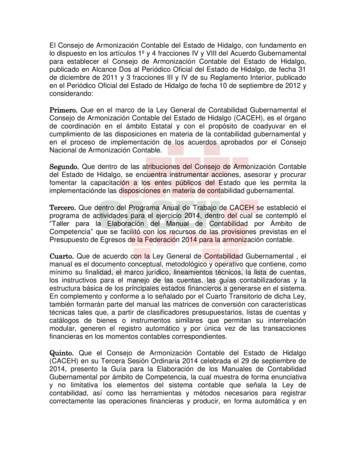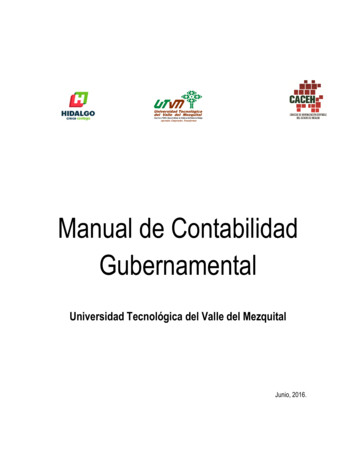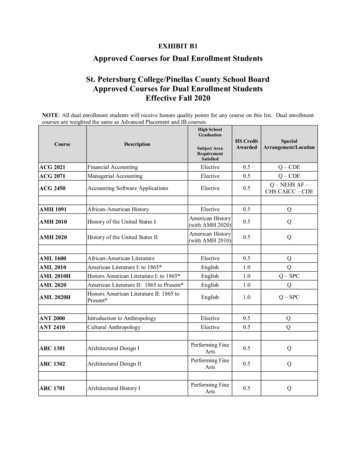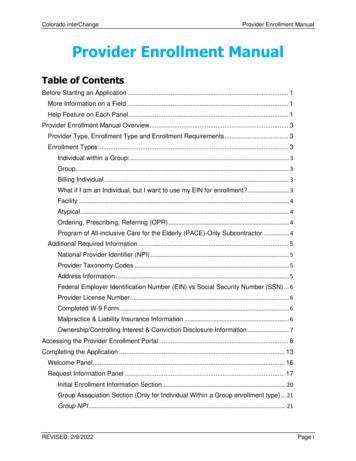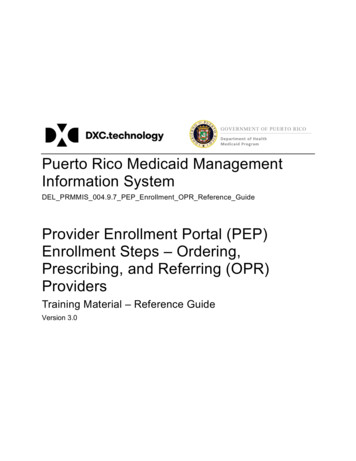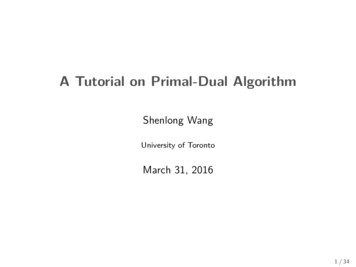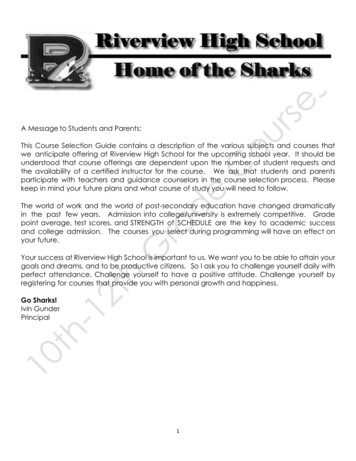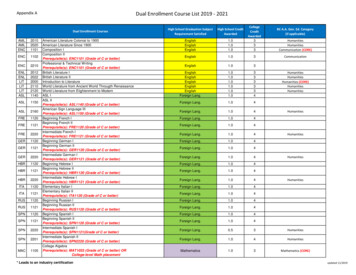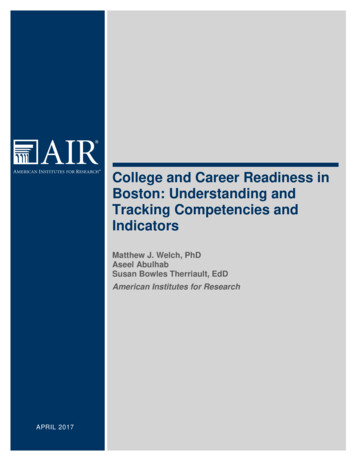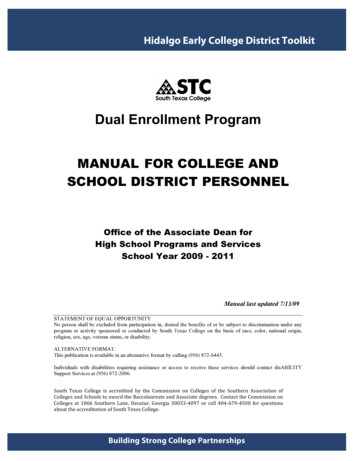
Transcription
Hidalgo Early College District ToolkitDual Enrollment ProgramMANUAL FOR COLLEGE ANDSCHOOL DISTRICT PERSONNELOffice of the Associate Dean forHigh School Programs and ServicesSchool Year 2009 - 2011Manual last updated 7/13/09STATEMENT OF EQUAL OPPORTUNITYNo person shall be excluded from participation in, denied the benefits of or be subject to discrimination under anyprogram or activity sponsored or conducted by South Texas College on the basis of race, color, national origin,religion, sex, age, veteran status, or disability.ALTERNATIVE FORMAT:This publication is available in an alternative format by calling (956) 872-6443.Individuals with disabilities requiring assistance or access to receive these services should contact disABILITYSupport Services at (956) 872-2006.!"# %& '()* & ,"--(.(& / & *001(2/ (2& 34& %(& ,"55/ /"6& "6& ,"--(.( & "7& %(& !"# %(16& 8 "0/* /"6& "7&,"--(.( &*62&!0%""- & "&*9*12& %(&:*00*-*#1(* (&*62&8 "0/* (&2(.1(( ;&&,"6 *0 & %(&,"55/ /"6&"6&,"--(.( & * & & !"# %(16& ?*6(@& A(0* #1@& B("1./*& CDDCCEFDGH& "1& 0*--& FDFE HGEFIDD& 7"1& J#( /"6 &*3"# & %(&*001(2/ * /"6&"7&!"# %&'()* &,"--(.(;&College Partnerships
TABLE OF CONTENTSSection IIntroduction.3Section IIProcedures & Guidelines. 4-13Memorandum of Understanding .4Classification of Dual Enrollment Faculty .4Credentialing of DE Faculty .4Dual Enrollment Faculty Teaching Load.4Dual Enrollment Program Procedures .5Selection & Dismissal.5Approval Process .6Course Monitoring Process.7Responsibilities .8Textbooks/Contact Hours . . . 9Continuation & Expectations.10Due Dates .11Dual Enrollment Course Agreements .12Tuition & Student Fees . . . 13Section IIIAdmission . 14-15Steps to Admission .14Eligibility Criteria .14Table I: Minimum Test Scores for Student Eligibility .15Registration .15Maximum Course Load .15Table II: Courses Allowed to Take Based on THEA Scores.15Section IVGranting of College Credit .16Transcripts.16State Approved Credit.16Transfer of Academic Dual Credit Courses.16Section VContact Information 17APPENDIX .18-24Appendix A: Memorandum of Understanding . . .19Appendix B: Dual Enrollment Course Agreement .21Appendix C: Dual Enrollment/Academic Dual Credit Checklist .23Appendix D: State Laws .24Appendix E: State Funding 252
SECTION I: INTRODUCTIONSouth Texas College (STC) allows eligible high school students to enroll in college courseswhile attending high school and permits them to take courses in place of, or in addition to, thenormal course load at their high school in its Dual Enrollment program. High school studentsmust be eligible to participate in the program to receive college credit. In addition, high schoolstudents admitted to the program must meet the same requirements as all other college studentswithin the guidelines established by The Higher Education Coordinating Board (THECB).College credit earned upon successful completion of the course may be applied towards anAssociates Degree at STC or may transfer to other colleges and universities.Working in collaboration with school districts and high school personnel, STC invites wellqualified high school juniors and seniors to enroll in the Dual Enrollment program. Studentsparticipating in the Dual Enrollment program may receive college credit only, or both highschool and college credit - academic dual credit -, as determined by the policy of the student’shigh school.Reports often cite low post-secondary participation rates of high school graduates in Hidalgo andStarr Counties. The Dual Enrollment program builds an academic bridge to college, providingstudents and their parents with a preview of post secondary standards and expectations whilestudying in a familiar high school classroom setting.For families, this program also provides an enriched and challenging learning experience at anaffordable cost. Students remain at their local school campus, enjoying the benefits of highschool participation while earning college-level credit.This program also encourages collaboration between professional educators at the high schooland the college level. Faculty work together to develop curricula that meets standards set by theTexas Education Agency (TEA), the Texas Higher Education Coordinating Board (THECB) andthe Southern Association of Colleges and Schools (SACS). Curriculum content must address theidentified college level competencies, as well as the learning outcomes of the Texas EssentialKnowledge and Skills (TEKS) in the program.Benefits to the community in developing a better-prepared workforce will accrue as the DualEnrollment program expands. This innovative program exemplifies how STC is fulfilling itsmission to provide quality academic education in order to open pathways to satisfying careers forthe youth of Hidalgo and Starr Counties.3
SECTION II: PROCEDURES AND GUIDELINES (DEPG)The selection and offering of Dual Enrollment courses is a shared responsibility between STCand each School District. Each institutional representative is responsible for upholding all courserequirements and agreements.Memorandum of Understanding:The Memorandum of Understanding (MOU) authorizes the offering of Dual Enrollment coursesat participating School Districts. South Texas College’s Board of Trustees as well as the SchoolBoard of each participating School District approves the MOU, which outline the terms andconditions of the agreement between STC and participating School Districts (Dual EnrollmentManual). The MOU remains in effect until the agreement is updated, recorded, and placed on filewith the participating school district and with South Texas College.Classification of Dual Enrollment Faculty:Dual Enrollment faculty are high school instructors who have been approved to teach STC DualEnrollment college courses at their high schools during the school day. This is facilitated througha Memorandum of Understanding (MOU) between STC and participating School Districts (STC,Faculty Handbook).Credentialing of Dual Enrollment Faculty:Dual Enrollment faculty must meet the minimum credential requirements as stated in STC BoardPolicy #4151: Academic and Professional Credentials of Faculty for postsecondary instructorsin the course/discipline for teaching college-level courses. .”The College has adopted theCommission Guidelines for Faculty Credentials, published by the Southern Association ofColleges and Schools for defining faculty qualifications.” ”All degrees earned by faculty andwhich fulfill the requirements of the Southern Association of Colleges and Schools Principles ofAccreditation must be from a regionally accredited institution and the College is committed torecruiting and selecting faculty whose highest degree is earned from a broad representation ofregionally accredited institutions”.South Texas College is responsible for ensuring that all Dual Enrollment courses are taught byqualified faculty regardless of location of the class (i.e., college campus, high school campus, orsatellite site).Dual Enrollment Faculty Teaching Load:Dual Enrollment faculty are full-time employees of their School District and are contractuallyobligated to teach an assigned number of classes during the day by their School District. TheMOU between STC and participating school districts states that “ the College will conductenrollment registration at the School District each semester for all qualified students who havemet all TAKS or TSI requirements and are requesting enrollment ”. Therefore, the number ofclasses that are offered for dual enrollment is determined by the number of qualifying studentsand may vary from high school to high school.4
However, the maximum size for courses should be no more than twenty-five (25) students persection, unless in those instances whereby course limitations set the maximum class size lower.These instances include Career and Technology courses, Nursing and Allied Health courses, andEarly College High School courses.DUAL ENROLLMENT PROGRAM PROCEDURESThe responsibilities of the School Districts and of South Texas College as well as the process foridentification, application, and approval for Dual Enrollment faculty are outlined as followed:SCHOOL DISTRICT IDENTIFICATION OF DUAL ENROLLMENT FACULTYThe High School Principal or designee will: Identify prospective DE Faculty who will meet the credentialing criteria by June 1st ofeach year;Submit the transcripts of any faculty who meet the requirements for teaching STCcourses to South Texas College’s Office for High School Programs and Services;Submit a letter of support for the prospective Dual Enrollment faculty indicating thefaculty member’s teaching history and potential contributions to the Dual Enrollmentprogram and to South Texas College.STC’s Office for High School Programs and Services Responsibilities: Communicate with the School District the qualifications for college faculty;Meet with the prospective Dual Enrollment faculty member and provide the STCEmployee Application Form for interested high school instructors to complete;Evaluate the prospective Dual Enrollment faculty’s credentials and official transcriptsbefore forwarding the documents to Department Chair.Assure that the applicant submits the application packet to the STC Office of HumanResources for review and processing after approval by the respective STC Chair andDivision Dean.Process the stipend for Dual Enrollment faculty each semester based on the number ofsections they teach.DUAL ENROLLMENT FACULTY SELECTION & DISMISSAL PROCESSDE Faculty Selection Process:A high school teacher who is identified as a prospective DE Faculty member must complete anSTC application packet that will include: STC Application Letter of Intent Résumé Any certifications, awards, and/or any other documents pertinent to the course that theapplicant will be teaching or pertinent to professional credentialing List of Professional References (STC Department Chair will have the option to conductreference checks)5
DE Faculty must ensure that official transcript(s) from an accredited college or university wherethe degree was awarded are mailed directly to the STC Office of Human Resources (HR). Theofficial transcript(s) must be received at HR before the start of the college semester in order tosecure the DE Faculty’s member status as such and to ensure the course offering for thesemester.The prospective DE Faculty is responsible for contacting the STC Office of Human Resources todetermine application deadlines and procedures. The faculty may call (956) 872-3722 or visit theHR office located at 2501 W. Pecan, McAllen.DE Faculty Dismissal Process:STC Board Policy #4115 outlines the dismissal process for faculty members. Policy #4115,states that, “Any faculty member employed as an adjunct, or as a temporary full time, or as grantfunded employee, or as a Dual Enrollment faculty, is employed on a non-contractual, at willbasis.” Reasons for non-approval of any candidate, or for dismissal from the program as a DualEnrollment faculty, should be provided by the Chair and the Division Dean to the AssociateDean for High School Programs and Services for dissemination back to the DE Faculty and theSchool District Administration.DUAL ENROLLMENT FACULTY APPROVAL PROCESSThe approval process for the DE Faculty member who will teach a dual enrollment course willbe consistent with the standards used to hire a faculty member for the course taught on the STCcampus. Merely having the credentials to teach college courses, is no assurance of approval intothe program. The department chair has full authority to interview and to make the final decisionregarding the approval and dismissal of faculty teaching courses for STC in the high schoolsbased on credentials, teaching experience, presentation, subject knowledge and otherinstructional factors related to the subject matter.A high school teacher who is identified as a prospective DE Faculty member must be approvedby the STC Department chair in the teaching discipline, by the Associate Dean for High SchoolPrograms and Services, and by the Office of Human Resources and meet the same qualificationsas STC faculty.Initial Approval of High School Instructor as DE Faculty:Department chair will use the following procedures as part of the approval process: Chair examines candidate’s application packet Chair conducts the initial interview with the applicant Chair reviews and confirms that the candidate’s academic credentials meet STC BoardPolicy #4151: Academic and Professional Credentials of Faculty Chair has the option to use a division /department standing committee (a standingcommittee will have up to three faculty members who teach in that discipline and onefaculty from outside of the department). When a standing committee is used the applicantwill be asked to meet with the committee for an interview and to demonstrate teaching6
proficiency. If this option is selected by the chair, the committee will conclude theiractivities and submit their assessment form to the Division Dean and the Associate Deanfor High School Programs and Services by the end of June.Chair submits the Intent to Hire form for applicants who receive approval to the DivisionDean and to HR for processing of the candidate.Continuation of High School Instructor as DE Faculty:After initial approval, a DE Faculty may continue teaching Dual Enrollment courses without theneed to undergo the approval process again contingent upon the following two items:1) Dual Enrollment courses being taught continuously each year in the same disciplineand/or teaching area; and2) Dual Enrollment faculty teaching the course adequately meets all faculty evaluationsrequirements, departmental requirements, responsibilities, and procedures.DUAL ENROLLMENT COURSE MONITORING PROCESSAccording to the Memorandum of Understanding (MOU) between STC and participating SchoolDistricts, the College will monitor the quality of instruction in order to assure compliance withthe Dual Enrollment Course Agreement and the standards established by the state of Texas, theSouthern Association of Colleges and Schools (SACS), the College, and the School District.Department Chair Responsibilities:Upon being approved for Dual Enrollment courses, the Department Chair should: Meet with the DE Faculty to discuss the particular requirements for the department asneeded; Provide DE Faculty access to the electronic version of the faculty handbook so that allDE Faculty can adhere to the professional guidelines, policies, procedures, rules, andexpectations; Provide DE Faculty access to student handbook detailing add/drop and withdrawalpolicies, student code of conduct, grading policies, critical dates, and other pertinentinformation; Provide assistance to the DE Faculty as a mentor or assign a full-time faculty mentor inthe same discipline to ensure that appropriate academic expectations have been set andare being followed. The Chair will provide the overall guidance and support to the DE Faculty. The Chair will provide information about the DE Faculty mentors to the Officeof the Associate Dean for High School Programs and Services; Inform DE Faculty that they are expected to participate in the College’s ProfessionalDevelopment activities; Provide the DE Faculty with the opportunity to attend at least one department meetingduring the semester; and Provide contact hours information to the Dual Enrollment faculty and explain how manyinstructional hours need to be met to ensure fulfilling required contact hours.7
Monitoring process: The Department Chair will have the option to conduct multiple observations during thefirst year of review that the Dual Enrollment faculty is teaching the college-level courseat the high school. The time for observations should be coordinated with the DE Facultyprior to the observation. Should the Department Chair have difficulty in contacting theDE faculty through STC and School District email communication or phone calls, theDepartment Chair may conduct an observation without prior arrangements. Thesemultiple observations could provide assurances to the chair that the DE Faculty isfollowing the college course syllabus and is teaching the course at the required rigor.Chair will have the option to require DE Faculty to attend monthly agreed-upondepartmental meetings at STC. The meeting schedules will be provided to the DE Facultybefore the beginning of semester so that the DE Faculty can coordinate his/her teachingresponsibilities at the high school in order to attend the required departmental meetings.Classroom Observation: All DE Faculty teaching dual enrollment courses shall be observed by a full-time facultymember or administrator using the same criteria as for full-time and/or adjunct faculty.New DE Faculty will be observed during their first semester of teaching.All Dual Enrollment faculty will have a minimum of one observation per year. However,the Chair of the department has the option to conduct additional observations eachsemester as part of their monitoring process.STC Policy and Procedures:Even though DE Faculty members are full-time employees of the School District wherein theyteach the college course(s), Dual Enrollment faculty are expected to follow all STC policies asapplicable during the instructional time designated for Dual Enrollment courses.RESPONSIBILITIESDE Faculty Responsibilities when Teaching a STC Dual Enrollment Course:Curriculum, Course Competencies, and Teaching Requirements: DE Faculty will develop the course outlines or syllabi, including the following: adescription of content, teaching strategies, performance measures, grading standards,resource materials, objectives/outcomes, and course calendar. The syllabus must bereviewed and approved by the STC Department Chair of the discipline within the firstweek of instruction; DE Faculty will complete all STC departmental requirements such as diagnostic tests andStudent Learning Outcomes/Exemplary Educational Objectives (for appropriate courses); DE Faculty will teach the course. Because of the Texas Higher Education CoordinatingBoard and the Southern Association of Colleges and Schools, if a DE Faculty is unable toteach the course, arrangements must be made by contacting the Department Chair prior toabsence; DE Faculty will advise students concerning their academic progress prior to the last dayto drop/withdraw from STC;8
DE Faculty will assign the student a letter grade for STC through JagNet. Once gradesare entered into Jagnet, grades can only be changed as a result of an error in the gradeissued, an error in processing the grade, or in the instance with an “Incomplete” grade,student completion of course requirements. A grade change form should be submitted tothe Department Chair. Should a DE faculty member continue instruction beyond the STCsemester, the grade reported to the high school might differ as the grade might includeadditional work or work differing from the requirements of the college course’DE Faculty will provide the Chair of the Department at STC, as requested, a copy of thegrade sheet for the class showing all exam scores, the term paper score (if any), the finalexam score, and the final course grade.DE Faculty will participate in aligning the high school and college course competencieswith the assigned STC Program Chair;DE Faculty will attend STC planning meetings and staff development activities,including dual enrollment training workshops; andDE Faculty will assist in the identification of potential dual enrollment students.Textbooks: DE Faculty are expected to use approved textbooks during the STC course. Textbooksmust be College-level and approved by the Department Chairs.The textbooks have to be available to the students on the first day of class.According to the established MOU, College-approved textbooks purchased by the schooldistrict may be used for a minimum of three years from the date of the purchase. Chairsmay request for a change of textbook earlier than three years, if the textbook is for atechnology-based course. A new textbook adoption needs to be communicated to theAssociate Dean of the High School Programs and Services by the 1st of March of eachyear.Contact Hours Pertaining to Dual Enrollment Faculty: DE Faculty are obligated to meet the required number of contact hours per semester.Therefore, absences, dismissal of classes, and early release (except in emergency), are inviolation of the contract between the Dual Enrollment faculty member, the College andthe Texas Higher Education Coordinating Board.In order to ensure meeting of required contact hours, Dual Enrollment faculty areexpected to make up lost contact hours.Contact Hours Pertaining to Dual Enrollment Students: Also, contact hours for students are equally important. Students enrolled in DualEnrollment courses are required to maintain regular and punctual attendance in class andlaboratories. According to STC Board Policy #3335, the student is responsible tocommunicate with faculty members concerning any absence. The student may berequired to present evidence to support an absence, and make–up work for class absenceswill be permitted only as specified by the faculty in the course syllabus. Dropping acourse is the responsibility of the student and not taking the appropriate steps may resultin an “F” for the course. In addition to Division based guidelines related to attendance,9
faculty may drop students, prior to the withdrawal deadline when, in the opinion of thefaculty, the student would have difficulty in successfully completing the course.In line with the importance of contact hours and attendance, students may not be added toa course after Census date, unless an error in the registration process occurs.Student Evaluation of Faculty Performance:DE Faculty will be evaluated by the students once a semester using the same evaluationinstrument used on campus. The student evaluation forms will be disseminated to the DE Facultyby the Outreach Department or the Office for High School Programs and Services. Theseevaluations must be returned to the high school contact on campus by the designated date so thata representative from STC can collect the evaluations.CONTINUTION OF DUAL ENROLLMENT COURSE OFFERINGSThrough the Memorandum of Understanding (MOU), STC waives all student tuition and fees forcollege courses held at the high school and taught by either Dual Enrollment faculty or by anSTC faculty member teaching the course at the high school. The MOU is a binding agreement,and should either party fail to adhere to its responsibilities therein, the removal of DualEnrollment courses will be considered if the infraction is not corrected after documentation.These responsibilities include those expected for the DE faculty, the High School and/or SchoolDistrict, and STC.EXPECTATIONS OF HIGH SCHOOLS AND SCHOOL DISTRICTSFor DE Faculty: Submit names of all Dual Enrollment faculty by June 1st; Support the DE faculty’s attendance to STC’s Professional Development Days; and Support the DE faculty attendance to Departmental meetings;For STC Faculty: Request an STC faculty member (part-time or full-time) to teach a college course at theschool by April 1st for fall semester classes, and September 1st for the spring semester.Exceptions to these deadlines may be presented to the Chair for consideration but theultimate decision rests in the chair’s decision as a result of the impact on the staffing ofcourses on STC’s campuses; Cover the mileage and the instructor’s cost based on the number of instructional contacthours for the course; and Provide STC faculty with information regarding important policies.For High School and School District Administration: Adhere to STC’s Board Policies over the School District’s Board Policies during theinstructional time for the dual enrollment course; Adhere to STC’s disciplinary procedures for faculty and students; Adhere to STC’s complaint procedures for faculty and students;10
Ensure instructional integrity by allowing the faculty member to teach the course thesame as if taught on STC’s campus;Comply with STC Board Policy #3010: Academic Integrity, STC Board Policy #3021:Student Recruitment and Instructional Integrity, and STC Board Policy #3030: AcademicFreedom;Submit requests for new course offerings by the deadline;Purchase and have available the required number of textbooks for all the students prior tothe first day of college courses;Ensure the classroom used to teach dual enrollment courses is an adequate environmentwith little or no interruptions, located as much as possible, away from the main studenttraffic of the school building, and with the technology arrangement adequate for thedelivery of classroom instruction;Finalize student enrollment prior to the start of the class for classes taught by STCfaculty. Schedule changes to add students to a course should not be made after two classmeetings. Additional enrollments beyond two class meetings and above the maximumclass size require the faculty member approval.Provide information with two class days prior notice regarding changes to instructionaltime including, but not limited to, school assemblies, pep-rallys, special events,Benchmark Testing, and standardized testing (TAKS, ACT, SAT, orTHEA/ACCUPLACER)Accept the faculty member’s attendance requirements as supported by STC Board Policy#3335DUE DATESJanuary 1March 1April 1June 1June 30June 30September 1School Districts will submit requests for the addition of new coursesto be offered on their campus for the Fall semester.STC Chairs will communicate new textbook adoption needs to theAssociate Dean of the High School Programs and Services by the 1stof March of each year.School Districts will submit their requests for a STC faculty member(part-time or full-time) to teach a college course at the high school byApril 1, for fall semester.School Districts will identify prospective DE Faculty who could meetthe credentialing criteria by June 1st of each year for fall semester.STC Chair who uses division /department standing committee toapprove a DE faculty will conclude their activities and submit theirassessment form to the Division Dean and the Associate Dean forHigh School Programs and Services by the end of June.School Districts will submit requests for the addition of new coursesto be offered on their campus for the Spring Semester.School Districts will submit their request for a STC faculty member(part-time or full-time) to teach a college course at the high school bySeptember 1, for Spring Semester.11
DUAL ENROLLMENT COURSE AGREEMENT The Dual Enrollment Course Agreement (DECA) is a legal document, which delineatesacademic and fiscal arrangements for the Dual Enrollment course. (See Appendix A,page 16.) Once the MOU is signed, the DECA is initiated as an original document at STC. This is signed by the School District and the College Examiners, and approved by theSchool District Superintendent (or designee) and the College’s Chief Academic Officer(or designee). Signed Dual Enrollment Course Agreements must be returned to STC prior to theCollege’s official census day (twelfth day of class). In the case of dual credit courses, the School District will ascertain that the college coursecompetencies meet or exceed the Texas Essential Knowledge and Skills (TEKS) of thehigh school course. As each new Dual Enrollment course is developed, a DECA is completed and the coursesyllabus is established. Each semester, the DECA and syllabus will be updated for each course. These materials must be on file at the College, as well as at the School District.STC Mentor Faculty Member: The STC Division Dean will assign a mentor faculty member to the high schoolinstructor, usually the department chair. The mentor will work with the high school instructor in the articulation of the course, thedevelopment of the syllabus, the evaluation of the course and instructor, and will provideany other assistance needed by the instructor.TUTION AND STUD
South Texas College is responsible for ensuring that all Dual Enrollment courses are taught by qualified faculty regardless of location of the class (i.e., college campus, high school campus, or satellite site). Dual Enrollment Faculty Teaching Load: Dual Enrollment faculty are full-time employees of their School District and are contractually
